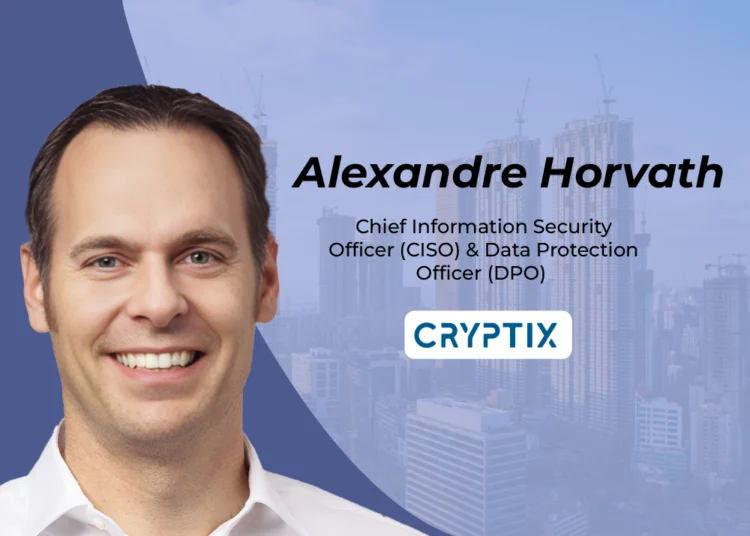As technology continues to evolve at breakneck speed, so does the complexity of cyber threats. Today, cybersecurity is a high-stakes game that’s constantly changing. This dynamic field requires leaders who can not only protect current systems but also anticipate future challenges. The responsibility extends beyond mere data protection to safeguarding the digital foundations of our modern world.
Alexandre Horvath, the Chief Information Security Officer (CISO) and Data Protection Officer (DPO) at Cryptix AG, stands out as a visionary in this complex arena. His approach to cybersecurity goes beyond reactive measures, focusing on proactive strategies that reshape the industry’s core principles. This interview aims to explore Alexandre’s unique perspectives, examining how his leadership is influencing the trajectory of cybersecurity.
We’ll delve into Alexandre’s professional journey, his insights on emerging trends, and his aspirations for the field’s future. Through this conversation, we seek to understand the mindset of a pioneer who is actively molding the landscape of digital security for generations to come.
Alexandre, can you shed some light on your journey that led you to become the CISO and DPO at Cryptix AG?
My journey into the world of cybersecurity and data protection has been an exciting and rewarding adventure. It all began with a deep-rooted passion for technology and a keen interest in understanding how systems work and how they can be safeguarded against threats.
My early career was marked by a rigorous education in computer science, where I developed a strong foundation in network security and information systems. I was fortunate to work with some incredible mentors who nurtured my curiosity and challenged me to think critically about the evolving landscape of cybersecurity.
Over the years, I gained valuable experience working with various organizations, where I took on roles that allowed me to hone my skills in threat detection, risk management, and data protection. Each role brought new challenges and learning opportunities, shaping me into the professional I am today.
Joining Cryptix AG was a significant milestone in my career. As a company dedicated to pioneering secure and innovative blockchain solutions, Cryptix provided the perfect platform for me to apply my expertise in both cybersecurity and data protection. Here, I have the opportunity to work with a talented team, drive our security initiatives, and ensure the integrity and confidentiality of our data.
As the CISO and DPO at Cryptix AG, my mission is to continuously strengthen our security posture, stay ahead of emerging threats, and foster a culture of security awareness within the organization. I’m excited about the future and look forward to the challenges and opportunities that lie ahead.
How do you see the role of CISO evolving by 2024, especially in the context of rapidly advancing technologies?
As we look ahead to 2024, the role of the CISO is set to undergo significant evolution, driven by the rapid advancement of technologies and an increasingly complex threat landscape. Here’s how I envision the role of the CISO evolving over the next few years:
By 2024, the CISO will increasingly be seen as a strategic leader within the organization. The role will go beyond technical expertise to encompass a deep understanding of business objectives and alignment with the overall company strategy. CISOs will work closely with executive teams to ensure that cybersecurity initiatives support and enhance business goals, driving competitive advantage and innovation.
With the rise of AI and machine learning, CISOs will leverage advanced threat intelligence and predictive analytics to anticipate and mitigate cyber threats before they materialize. This proactive approach will involve continuous monitoring, real-time data analysis, and the use of AI-driven tools to identify and respond to emerging threats swiftly and effectively.
As data privacy regulations become more stringent and consumer awareness of data protection grows, the CISO’s role will increasingly focus on ensuring compliance with data protection laws and safeguarding sensitive information. This will involve implementing robust data governance frameworks, enhancing encryption methods, and fostering a culture of privacy within the organization.
The integration of cybersecurity into the DevOps process, often referred to as DevSecOps, will become a standard practice by 2024. CISOs will play a crucial role in embedding security into every stage of the software development lifecycle, ensuring that security considerations are integral to design, development, testing, and deployment.
The concept of cyber resilience—preparing for, responding to, and recovering from cyber incidents—will be central to the CISO’s agenda. This involves not only implementing robust security measures but also developing comprehensive incident response plans, conducting regular cybersecurity drills, and fostering a culture of resilience throughout the organization.
CISOs will be pivotal in championing a strong cybersecurity culture within their organizations. This means leading by example, promoting continuous cybersecurity education and awareness programs, and ensuring that every employee understands their role in maintaining the organization’s security posture.
As cyber threats become more sophisticated, collaboration and information sharing with industry peers, government agencies, and cybersecurity organizations will be crucial. CISOs will actively participate in cybersecurity networks and partnerships, contributing to and benefiting from collective intelligence and resources.
The role of the CISO is set to become even more dynamic and multifaceted by 2024. As organizations navigate the complexities of rapidly advancing technologies and evolving cyber threats, CISOs will be at the forefront, driving strategic initiatives, fostering resilience, and ensuring that cybersecurity is a fundamental component of business success.
As someone with a flair for new technologies, which emerging tech do you believe will have the biggest impact on cybersecurity in the near future?
As someone deeply passionate about new technologies, I am always on the lookout for innovations that can transform the cybersecurity landscape. The rapid pace of technological advancement brings both opportunities and challenges, and certain emerging technologies are set to have a profound impact on how we approach cybersecurity in the near future. Here are some of the most promising technologies that I believe will shape the future of cybersecurity:
Artificial Intelligence (AI) and Machine Learning (ML) are already making significant strides in cybersecurity, and their impact is only set to grow. These technologies enable the development of advanced threat detection systems that can analyze vast amounts of data in real-time, identify patterns, and detect anomalies that may indicate cyber threats. By leveraging AI and ML, organizations can enhance their ability to predict, prevent, and respond to cyber-attacks more effectively.
Quantum computing has the potential to revolutionize cybersecurity, both in terms of creating new threats and providing powerful tools for defense. On one hand, quantum computers could potentially break traditional encryption methods, necessitating the development of quantum-resistant encryption algorithms. On the other hand, quantum computing can significantly enhance cryptographic techniques, enabling more secure communication and data protection.
Blockchain technology offers a decentralized and tamper-proof way to record transactions and data, making it a powerful tool for enhancing cybersecurity. Its ability to provide immutable records and ensure data integrity can be leveraged to secure sensitive information, authenticate identities, and prevent fraud. Additionally, blockchain’s decentralized nature reduces the risk of single points of failure, making systems more resilient to attacks.
The Zero Trust model is gaining traction as a robust approach to cybersecurity. Unlike traditional security models that rely on perimeter defenses, Zero Trust assumes that threats can exist both inside and outside the network. It requires continuous verification of users and devices, implementing strict access controls, and monitoring for suspicious activity. Adopting Zero Trust principles can significantly enhance an organization’s security posture in an increasingly complex threat environment.
Extended Detection and Response (XDR) is an emerging approach that integrates multiple security products into a cohesive system for holistic threat detection and response. By consolidating data from various sources, such as endpoints, networks, and cloud environments, XDR provides a unified view of an organization’s security landscape. This enables faster and more accurate threat detection, investigation, and response, improving overall cybersecurity efficacy.
As privacy concerns continue to grow, privacy-enhancing technologies (PETs) are becoming increasingly important in cybersecurity. These technologies, including homomorphic encryption, differential privacy, and secure multi-party computation, enable the analysis and sharing of data without compromising privacy. By adopting PETs, organizations can protect sensitive information while still deriving valuable insights from their data.
The future of cybersecurity is being shaped by these and other emerging technologies, each offering unique capabilities to enhance our defenses against ever-evolving cyber threats. As we continue to innovate and embrace these technologies, we can build a more secure and resilient digital landscape.
What are your thoughts on the ethical considerations of data protection in an increasingly AI-driven world?
As we continue to embrace the transformative power of artificial intelligence (AI) in our everyday lives, the ethical considerations of data protection have become more critical than ever. The intersection of AI and data protection presents both unprecedented opportunities and significant challenges. Here are my thoughts on the ethical considerations we must address to ensure the responsible and ethical use of AI in this context:
In an AI-driven world, vast amounts of personal data are collected, analyzed, and utilized to power intelligent systems. Ensuring that individuals’ privacy is respected and their consent is obtained is paramount. Organizations must be transparent about what data they collect, how it will be used, and provide clear options for individuals to opt-in or out. Consent should be informed, explicit, and revocable at any time.
With the increasing reliance on AI, the security of data becomes even more crucial. Ensuring robust data protection measures to prevent unauthorized access, breaches, and misuse is an ethical obligation. This includes implementing strong encryption, access controls, and regular security audits. The responsibility to safeguard data must be a top priority for any organization leveraging AI technologies.
AI systems are only as good as the data they are trained on. If the data contains biases, the AI will likely perpetuate these biases, leading to unfair and discriminatory outcomes. It is essential to scrutinize the data for any inherent biases and implement measures to mitigate them. Ensuring fairness in AI decision-making processes is an ethical imperative, particularly in areas such as hiring, lending, and law enforcement.
The complexity of AI systems can make it challenging to understand how decisions are made. This lack of transparency can lead to accountability issues. Organizations must strive to make their AI systems as transparent as possible, providing explanations for AI-driven decisions and ensuring there is accountability for any adverse outcomes. This includes maintaining audit trails and having mechanisms in place to address and rectify any errors or biases.
As AI systems often rely on large datasets, the question of data ownership and control becomes critical. Individuals should have control over their data, including the right to access, modify, and delete their information. Additionally, there should be clear guidelines on how data is shared and used by third parties, ensuring that individuals’ rights are not compromised in the process.
Beyond data protection, the ethical use of AI involves considering the broader societal impact of AI technologies. This includes evaluating the potential consequences of AI applications, ensuring they align with ethical standards, and avoiding uses that could harm individuals or society. Developing and adhering to ethical guidelines for AI development and deployment is essential to promote trust and prevent misuse.
As we navigate the AI-driven world, it is crucial to address these ethical considerations to ensure that data protection remains a top priority. By fostering a culture of transparency, accountability, and respect for individuals’ rights, we can harness the power of AI responsibly and ethically.
What trends do you foresee in the future of cybersecurity, and how is Cryptix AG preparing to adapt to these trends?
The world of cybersecurity is in a constant state of evolution, driven by rapid technological advancements and an ever-changing threat landscape. As we look to the future, several key trends are emerging that will shape the way organizations protect their digital assets. Here’s a look at these trends and how Cryptix AG is preparing to adapt and stay ahead in the cybersecurity game:
The AI and ML trend are becoming integral tools in identifying and mitigating cyber threats. These technologies can analyze vast amounts of data, detect anomalies, and respond to threats in real-time.
Cryptix AG is investing in AI and ML capabilities to enhance our threat detection and response systems. By incorporating these technologies, we can proactively identify potential threats and automate responses to reduce the impact of cyber-attacks.
The Quantum computing trend promises to revolutionize many fields, including cybersecurity. While it offers significant advantages, it also poses a threat to current encryption methods.
Cryptix AG is closely monitoring advancements in quantum computing and investing in research to develop quantum-resistant encryption techniques. This proactive approach ensures that our security measures remain robust in the face of future quantum threats.
The Zero Trust model trend, which assumes that threats can exist both inside and outside the network, is gaining traction. This model requires strict verification for every access request.
Cryptix AG is implementing Zero Trust principles across our infrastructure. This involves continuous verification of user identities, strict access controls, and comprehensive monitoring to ensure that only authorized users can access our systems and data.
With increasing regulatory requirements and growing public awareness, the data privacy and protection trend is more important than ever.
Cryptix AG prioritizes data protection by implementing robust encryption, data governance frameworks, and compliance with all relevant regulations. The Data Protection Officer (DPO) ensures that our practices align with the highest standards of privacy and data security.
The trend of integration of security into the DevOps process, known as DevSecOps, is becoming essential for ensuring secure software development and deployment.
Cryptix AG is embedding security into every stage of our software development lifecycle. By incorporating security practices early and continuously, we ensure that our applications are secure from the ground up.
The cyber resilience trend, the ability to prepare for, respond to, and recover from cyber incidents, is becoming a key focus for organizations.
Cryptix AG is enhancing our cyber resilience through comprehensive incident response plans, regular cybersecurity drills, and continuous improvement of our security posture. Our goal is to ensure that we can quickly recover from any cyber incident with minimal disruption.
As cyber threats become more sophisticated, collaboration and information sharing trends among organizations are critical for effective defense.
Cryptix AG actively participates in cybersecurity networks and partnerships, sharing insights and threat intelligence with industry peers. This collaborative approach helps us stay informed about emerging threats and leverage collective expertise to enhance our security measures.
At Cryptix AG, we are committed to staying ahead of cybersecurity trends and continuously evolving our strategies to protect our digital assets. By embracing emerging technologies, adopting innovative security models, and fostering a culture of resilience and collaboration, we are well-prepared to face the challenges of the future.
What inspires and motivates you the most in your work, and how do you maintain your passion for cybersecurity?
As a cybersecurity professional, I am often asked what inspires and motivates me in my work and how I maintain my passion for this ever-evolving field. The truth is, that the world of cybersecurity is filled with challenges and opportunities that fuel my drive every day. Here’s a glimpse into what keeps me inspired and passionate about cybersecurity:
One of the most exciting aspects of cybersecurity is the constantly evolving threat landscape. Cyber threats are becoming more sophisticated and varied, requiring continuous learning and adaptation. The challenge of staying ahead of these threats and developing innovative solutions to protect against them is a significant motivator for me. It’s a dynamic field where no two days are the same, and that keeps me engaged and motivated.
At the core of my work is the mission to protect people and organizations from cyber threats. Knowing that my efforts help safeguard sensitive information, prevent data breaches, and ensure the security of critical systems is incredibly rewarding. This sense of purpose drives me to stay committed to my work and strive for excellence in all that I do.
Cybersecurity is a field that demands continuous learning and professional growth. With new technologies, vulnerabilities, and attack vectors emerging regularly, there is always something new to discover and master. This constant learning environment keeps me intellectually stimulated and fuels my passion for staying at the forefront of cybersecurity advancements.
Working in cybersecurity often involves collaborating with talented professionals from diverse backgrounds. The opportunity to brainstorm, share insights, and develop innovative solutions with my colleagues is inspiring. These collaborative efforts not only enhance our collective knowledge but also drive the development of cutting-edge security measures that make a real difference.
The work we do in cybersecurity has a profound impact on society at large. By protecting critical infrastructure, securing personal data, and preventing cybercrime, we contribute to a safer digital world. Knowing that my work helps create a secure environment for individuals and businesses alike is a powerful motivator that keeps me passionate about my role.
In cybersecurity, staying ahead of the curve is crucial. The thrill of outsmarting cyber adversaries and developing proactive strategies to mitigate risks is a significant source of motivation. It’s a continuous race against time, and the drive to stay one step ahead keeps me energized and focused on my goals.
To maintain my passion for cybersecurity, I:
Engage in Continuous Learning: I regularly attend conferences, participate in webinars, and pursue certifications to stay updated with the latest trends and technologies.
Network with Peers: Connecting with other cybersecurity professionals and participating in industry forums and discussions helps me stay inspired and motivated.
Balance Work and Life: Maintaining a healthy work-life balance is essential. I make time for hobbies, exercise, and spending time with family and friends to recharge and stay motivated.
Celebrate Successes: Acknowledging and celebrating achievements, both big and small, keeps me motivated and reinforces my passion for cybersecurity.
The field of cybersecurity is challenging, dynamic, and incredibly rewarding. The ever-changing threat landscape, the mission to protect, and the continuous opportunities for learning and innovation inspire and motivate me every day. By staying engaged, connected, and balanced, I maintain my passion for this vital and impactful work.
How do you hope to be remembered in the field of cybersecurity and data protection? What legacy do you wish to leave behind?
As I reflect on my journey in the field of cybersecurity and data protection, I think about the legacy I wish to leave behind. In a constantly evolving landscape, my hope is to make a lasting impact that contributes to a safer and more secure digital world. Here are my thoughts on how I hope to be remembered and the legacy I aim to create:
I aspire to be remembered as an advocate for strong and proactive security practices. Throughout my career, I have emphasized the importance of not just reacting to threats, but anticipating and mitigating them before they become critical issues. I hope my work inspires others to adopt a proactive mindset in cybersecurity, ensuring that robust security measures are always a priority.
In an era where data is a valuable asset, I want to be recognized as a champion of privacy and ethical standards. Protecting individuals’ privacy and ensuring ethical use of data are principles I hold dearly. My goal is to leave a legacy where data protection and privacy are integral to every organization’s culture, and ethical considerations are at the forefront of technological advancements.
Innovation is key to staying ahead of cyber threats. I hope to be remembered for my contributions to developing innovative cybersecurity solutions that address emerging challenges. Whether through implementing advanced AI-driven threat detection systems or pioneering new encryption techniques, I aim to push the boundaries of what is possible in cybersecurity.
Mentorship and education have always been important to me. I strive to pass on my knowledge and experience to the next generation of cybersecurity professionals. I want to be remembered as someone who invested time and effort in mentoring young talent, fostering their growth, and helping them navigate the complexities of the field. My legacy includes empowering others to succeed and continue the mission of protecting our digital world.
Cybersecurity is a collective effort, and I believe in the power of collaboration. I hope to be remembered as someone who built and nurtured strong cybersecurity communities, encouraging information sharing and collective problem-solving. By fostering a spirit of collaboration, I aim to create an environment where cybersecurity professionals work together to tackle common threats and share best practices.
In addition to prevention, building resilience is crucial. I aspire to leave behind a legacy of promoting cyber resilience—preparing for, responding to, and recovering from cyber incidents. My work emphasizes the importance of comprehensive incident response plans, regular drills, and a culture of resilience that ensures organizations can withstand and quickly recover from cyberattacks.
I hope to be remembered as a dedicated and passionate cybersecurity professional who made meaningful contributions to the field. My legacy is one of advocacy for strong security practices, ethical standards, and innovation. I aim to inspire and mentor the next generation, build collaborative communities, and promote resilience in the face of ever-evolving cyber threats.
What is that one piece of wisdom you would like to give to the next generation of cybersecurity leaders?
As someone who has navigated the complex and ever-evolving field of cybersecurity, I often reflect on the lessons I’ve learned and the insights I’ve gained throughout my journey. If there is one piece of wisdom I could pass on to the next generation of cybersecurity leaders, it would be this:
The field of cybersecurity is dynamic, with new threats, technologies, and challenges emerging every day. To be effective and successful in this domain, it’s crucial to adopt a mindset of continuous learning and adaptation. Here’s why this piece of wisdom is so vital:
- Cyber threats are constantly evolving in sophistication and complexity. By committing to continuous learning, you can stay informed about the latest attack vectors, vulnerabilities, and defense mechanisms. This proactive approach allows you to anticipate and mitigate threats before they impact your organization.
- The rapid pace of technological advancement presents both opportunities and challenges. Embracing continuous learning enables you to understand and leverage emerging technologies like AI, machine learning, and quantum computing to enhance your cybersecurity strategies. Staying current with technological trends ensures you can integrate the best tools and practices into your security framework.
- The regulatory landscape for data protection and cybersecurity is continually evolving. Being well-versed in current laws, standards, and best practices is essential for compliance and ethical conduct. Continuous learning helps you stay updated on regulatory changes and adapt your policies and practices accordingly.
- As a cybersecurity leader, you have the responsibility to cultivate a culture of security awareness within your organization. By staying informed and educated, you can effectively train and guide your team, ensuring that everyone understands their role in maintaining the organization’s security posture.
- Continuous learning fosters resilience and innovation. It encourages you to think creatively and develop robust solutions to complex problems. Adaptability is key to overcoming challenges and emerging stronger from cyber incidents. By being open to new ideas and approaches, you can drive innovation and build a resilient cybersecurity infrastructure.
In conclusion, my one piece of wisdom for the next generation of cybersecurity leaders is to embrace continuous learning and adaptation. The cybersecurity landscape will always be in flux, but with a commitment to ongoing education and a flexible mindset, you can navigate these changes effectively and lead your organization to a secure future.

 More about Alexandre Horvath
More about Alexandre Horvath










